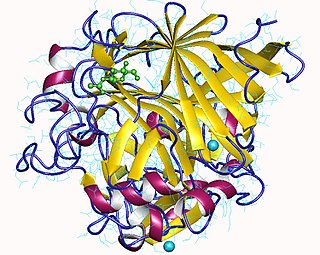
Cellulase is any of several enzymes produced chiefly by fungi, bacteria, and protozoans that catalyze cellulolysis, the decomposition of cellulose and of some related polysaccharides:
Isomaltase is an enzyme that breaks the bonds linking saccharides, which cannot be broken by amylase or maltase. It digests polysaccharides at the alpha 1-6 linkages. Its substrate, alpha-limit dextrin, is a product of amylopectin digestion that retains its 1-6 linkage. The product of the enzymatic digestion of alpha-limit dextrin by isomaltase is maltose.

β-Amylase is an enzyme with the systematic name 4-α-D-glucan maltohydrolase. It catalyses the following reaction:
In enzymology, a 1,4-alpha-glucan 6-alpha-glucosyltransferase is an enzyme that catalyzes the chemical reaction that transfers an alpha-D-glucosyl residue in a 1,4-alpha-D-glucan to the primary hydroxyl group of glucose or 1,4-alpha-D-glucan.
In enzymology, a xyloglucan-specific endo-beta-1,4-glucanase (EC 3.2.1.151) is an enzyme that catalyzes the chemical reaction

In enzymology, a cyclomaltodextrin glucanotransferase is an enzyme that catalyzes the chemical reaction of cyclizing part of a 1,4-alpha-D-glucan molecule through the formation of a 1,4-alpha-D-glucosidic bond. They are bacterial enzymes belonging to the same family of the α-amylase specifically known as glycosyl-hydrolase family 13. This peculiar enzyme is capable of catalyzing more than one reaction with the most important being the synthesis of non-reducing cyclic dextrins known as cyclodextrins starting from starch, amylose, and other polysaccharides.
In enzymology, a xyloglucan:xyloglucosyl transferase (EC 2.4.1.207) is an enzyme that catalyzes the chemical reaction in which a beta-(1,4) bond in the backbone of a xyloglucan in broken; the xyloglucanyl segment is then transferred to the O4 of the non-reducing terminal glucose residue of either xyloglucan or an oligosaccharide thereof.

Glucanases are enzymes that break down large polysaccharides via hydrolysis. The product of the hydrolysis reaction is called a glucan, a linear polysaccharide made of up to 1200 glucose monomers, held together with glycosidic bonds. Glucans are abundant in the endosperm cell walls of cereals such as barley, rye, sorghum, rice, and wheat. Glucanases are also referred to as lichenases, hydrolases, glycosidases, glycosyl hydrolases, and/or laminarinases. Many types of glucanases share similar amino acid sequences but vastly different substrates. Of the known endo-glucanases, 1,3-1,4-β-glucanase is considered the most active.
Beta-1,4-mannosyl-glycoprotein 4-beta-N-acetylglucosaminyltransferase is an enzyme with systematic name UDP-N-acetyl-D-glucosamine:beta-D-mannosyl-glycoprotein 4-beta-N-acetyl-D-glucosaminyltransferase. This enzyme catalyses the following chemical reaction
Glucan 1,4-α-maltotetraohydrolase is an enzyme with systematic name 4-α-D-glucan maltotetraohydrolase. It catalyses the hydrolysis of (1→4)-α-D-glucosidic linkages in amylaceous polysaccharides, to remove successive maltotetraose residues from the non-reducing chain ends
Glucan 1,6-α-glucosidase is an enzyme with systematic name glucan 6-α-D-glucohydrolase. It catalyses the hydrolysis of (1→6)-α-D-glucosidic linkages in (1→6)-α-D-glucans and derived oligosaccharides
Lichenase is an enzyme with systematic name (1→3)-(1→4)-β-D-glucan 4-glucanohydrolase. It was named after its activity in on lichenin.
The enzyme glucan 1,4-β-glucosidase, also known as 4-β-D-glucan glucohydrolase, catalyses the hydrolysis of (1→4)-linkages in 1,4-β-D-glucans and related oligosaccharides, removing successive glucose units.

Cellulose 1,4-β-cellobiosidase is an enzyme of interest for its capability of converting cellulose to useful chemicals, particularly cellulosic ethanol.
Glucan 1,4-α-maltohexaosidase is an enzyme with systematic name 4-α-D-glucan maltohexaohydrolase. It catalyses the hydrolysis of (1→4)-α-D-glucosidic linkages in amylaceous polysaccharides, to remove successive maltohexaose residues from the non-reducing chain ends
Branched-dextran exo-1,2-α-glucosidase is an enzyme with systematic name (1→2)-α-D-glucosyl-branched-dextran 2-glucohydrolase. It catalyses the hydrolysis of (1→2)-α-D-glucosidic linkages at the branch points of dextrans and related polysaccharides, producing free D-glucose.
Glucan 1,4-α-maltotriohydrolase is an enzyme with systematic name 4-α-D-glucan maltotriohydrolase. It catalyses the hydrolysis of (1→4)-α-D-glucosidic linkages in amylaceous polysaccharides, to remove successive maltotriose residues from the non-reducing chain ends.

Neopullulanase is an enzyme of the alpha-amylase family with systematic name pullulan 4-D-glucanohydrolase (panose-forming). This enzyme principally catalyses the following chemical reaction by cleaving pullulan's alpha-1,4-glucosidic bonds:
Exo-1,4-beta-D-glucosaminidase is an enzyme with systematic name chitosan exo-(1->4)-beta-D-glucosaminidase.! This enzyme catalyses the following chemical reaction
Cellulose 1,4-beta-cellobiosidase is an enzyme with systematic name 4-beta-D-glucan cellobiohydrolase . This enzyme catalyses the following chemical reaction






